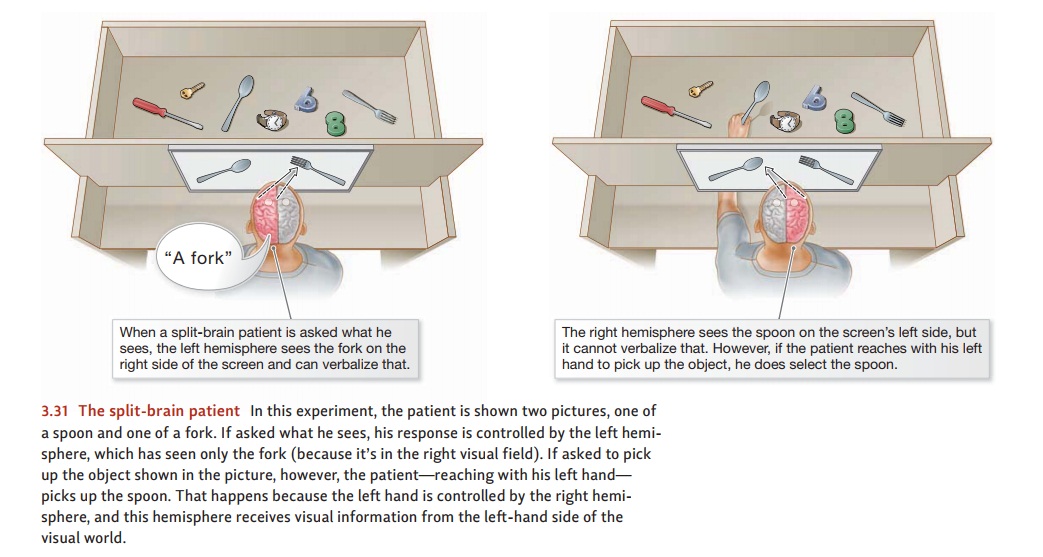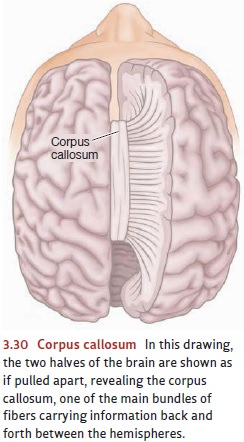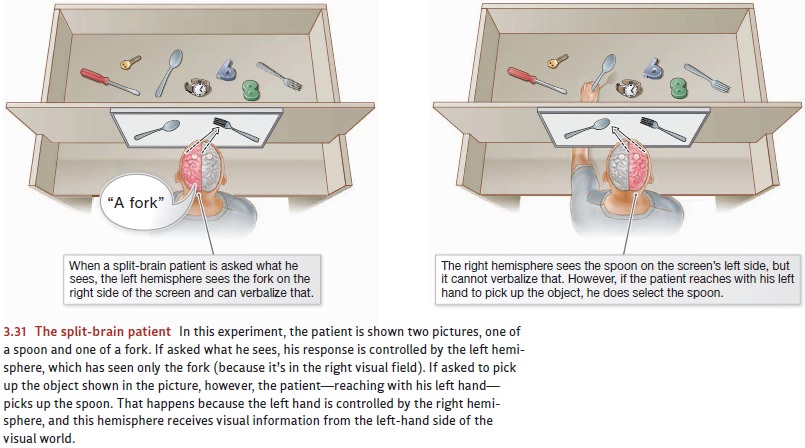Chapter: Psychology: The Brain and the Nervous System
Lateralization

Lateralization
The entire human brain is more or
less symmetrical around the midline, so there’s a thalamus on the left side of
the brain and another on the right. There’s also a left-side amygdala and a
right-side one. Of course, the same is true for the cortex itself: There’s a
temporal cortex in the left hemisphere and another in the right, a left
occipital cortex and a right one, and so on. In almost all cases—cortical and
subcortical—the left and right structures have roughly the same shape, the same
position in their respective sides of the brain, and the same pattern of
connections to other brain areas. Even so, there are some anatomical
distinctions between the left-side and right-side structures. We can also
document differences in function, showing that the left-hemisphere structures
play a somewhat different role from the corresponding right-hemisphere
structures.
The asymmetry in function between
the two brain halves is called lateralization,
and its manifestations influence phenomena that include language use and the
per-

ception and understanding of
spatial organization (Springer & Deutsch, 1998). Still, it’s important to
realize that the two halves of the brain, each performing somewhat different
functions, work closely together under almost all circumstances. This
inte-gration is made possible by the commissures—thick
bundles of fibers that carry infor-mation back and forth between the two
hemispheres. The largest and probably most important commissure is the corpus callosum, but several other
structures also ensure that the two brain halves work together as partners in
virtually all mental tasks (Figure 3.30).
In some people, these
neurological bridges between the hemispheres have been cut for medical reasons.
This was, for example, a last-resort treatment for many years in cases of
severe epilepsy. The idea was that the epileptic seizure would start in one
hemisphere and spread to the other, and this spread could be prevented by
disconnect-ing the two brain halves from each other (Bogen, Fisher, &
Vogel, 1965; D. Wilson, Reeves, Gazzaniga, & Culver, 1977). The procedure
has largely been abandoned by physicians, who are turning to less drastic surgeries
for even the most extreme cases of epilepsy (Woiciechowsky, Vogel, Meyer, &
Lehmann, 1997). Nonetheless, this medical procedure has produced a number of
“split-brain patients”; this provides an extraordi-nary research opportunity by
allowing us to examine how the brain halves function when they aren’t in full
communication with each other.
This research makes it clear that
each hemisphere has its own specialized capacities (Figure 3.31). For most
people, the left hemisphere has sophisticated language skills and is capable of
making sophisticated inferences. The right hemisphere, in contrast, has only
limited language skills; but it outperforms the left hemisphere in a variety of
spa-tial tasks such as recognizing faces and perceiving complex patterns (Gazzaniga,
Ivry, & Mangun, 2002; Kingstone, Freisen, & Gazzaniga, 2000).

These differences between the
left and right cerebral hemispheres are striking, but they’re clearly distinct
from many of the conceptions of hemispheric function written for the general
public. Some popular authors go so far as to equate left-hemisphere function
with Western science and right-hemisphere function with Eastern culture and
mysticism. In the same vein, others have argued that Western societies
overemphasize rational and analytic “left-brain” functions at the expense of
intuitive, artistic, “right-brain” functions.
These popular conceptions contain
a kernel of truth because, as we’ve seen, the two hemispheres are different in
several aspects of their functioning. But these often-mentioned conceptions go
far beyond the available evidence and are sometimes inconsistent with it
(Efron, 1990; J. Levy, 1985). Worse, these popular conceptions are entirely
misleading when they imply that the two cerebral hemi-spheres, each with its
own talents and strategies, endlessly compete for control of our mental life.
Instead, each of us has a single brain. Each part of the brain—not just the
cerebral hemispheres—is quite differentiated and so contributes its own
specialized abilities to the activity of the whole. But in the end, the
complex, sophis-ticated skills that we each display depend on the whole brain
and on the coordinated actions of all its components. Our hemispheres are not
cerebral competitors. Instead, they pool their specialized capacities to
produce a seamlessly integrated, single mental self.
Related Topics